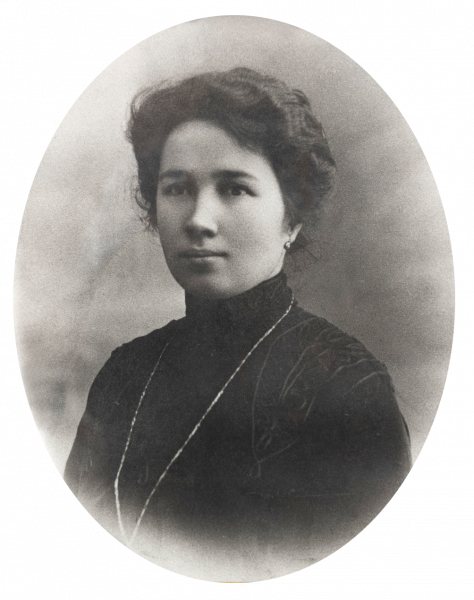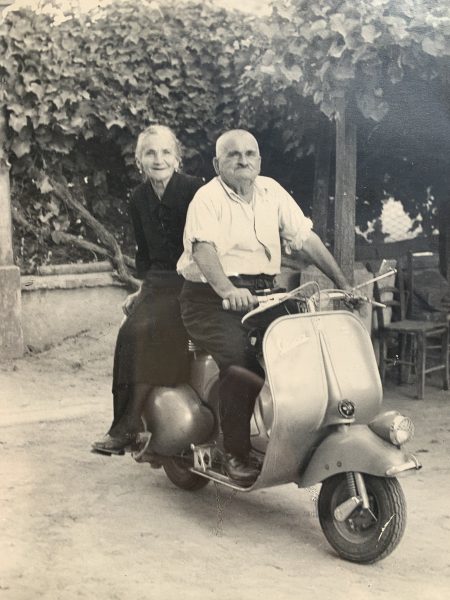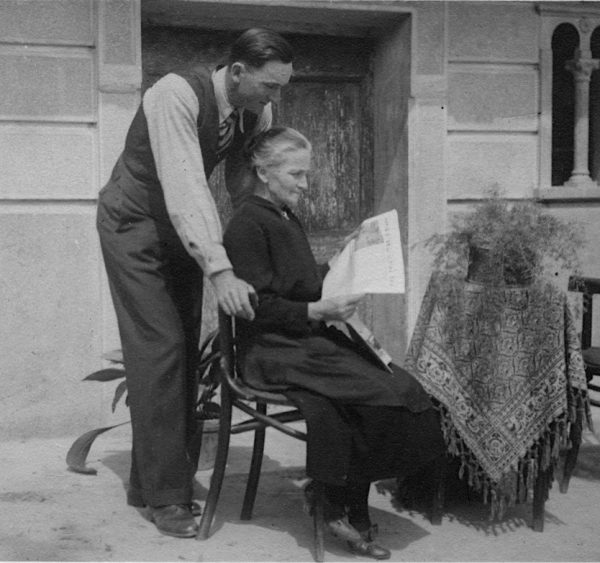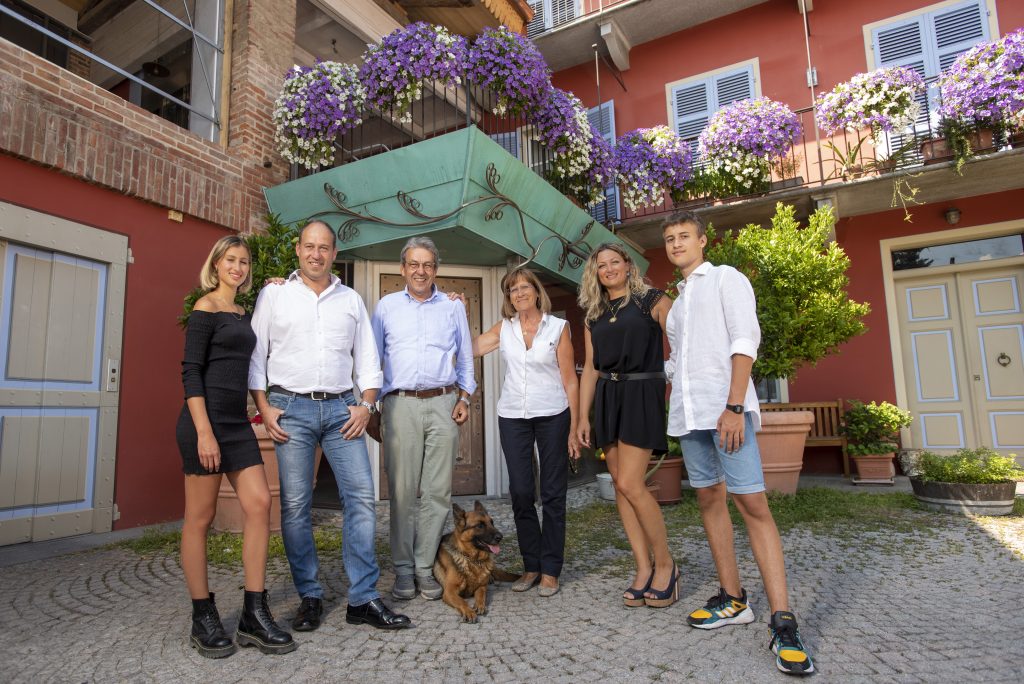History
The Monchiero Carbone winery is located in Canale, in the centre of the village, in a nineteenth century stately farmhouse, which hosts in its basement a large and fascinating historical cellar, untouched for over two centuries.
The company’s name bears the surnames of Marco Monchiero and Lucia Carbone, Francesco Monchiero’s parents, who started the production of wine using the vineyards inherited from each family. The origins and the connections with winemaking are, however, to be found in the past, among the members of the two families.
 Family
Family

Clotilde Valente, great-grandmother on the Monchiero line, is the forebearer. She married, at the “mature” age of thirty-one, Giovanni Raimondo, known as Job, who had just returned from America, where he had spent twelve years of his youth making his fortune. The outbreak of the Great War divided them almost immediately, leaving her alone, still without children, to manage their money and their future: in 1918 Clotilde decided to buy the Mombirone vineyard, which she then cultivated throughout her life, resulting in the creation of the family’s historic wine, Barbera d’Alba Monbirone. A small production first sold in bulk and then bottled from the 1961 vintage onwards till today thanks to her grandchildren Giovanni and Marco Monchiero who continued to make it during the 70s and 80s with great passion.
 Family
Family

We are still in the early 1900s when great-grandfather Enrico Carbone, known as Ricu, marries the young Lucia Gioetti: beautiful and slender, she was known as “the Blonde” by everyone. Lucia, daughter of the wealthy sharecropper of the Count of Canale, brings an considerable dowry and a good amount of money, which is obviously destined to the purchase of land on the Tanon hill (Tanùn), where Ricu immediately wanted to plant a vineyard with Arneis to produce that white wine kept sweet to conform to the taste of the time.

The Tanon vineyard would then pass into the hands of his grandfather Francesco Carbone, known as Cecu d’la Biunda, also passionate about Arneis.
Here are some anecdotes that reveal how in the past the ancestors of both families were related to the world of viticulture.
It was 1987 when Marco Monchiero, a nationally renowned oenologist, and his wife Lucia Carbone decided to buy the large farmhouse in Via S. Stefano Roero: they had just returned to the village following the wide-ranging work experience that Marco had gained in important Italian wineries.

When we returned to the village at the end of the ‘80s we bought the large house in Via Santo Stefano: I was attracted by the historic cellar, my wife by the large spaces. By the 1990 harvest we resumed the production of Barbera Monbirone in the new premises.
Marco Monchiero
In those years his son Francesco Monchiero, born in 1975, had already a very clear vision: “when he grew up” he would have wanted to produce his own wines by creating his own brand: it was in fact almost taken for granted that the son of a famous consultant oenologist, who grew up in wineries and vineyards all over Italy, could one day undertake his father’s studies and career. Less predictable that he would do so independently, creating his own company from scratch, involving his parents in the project.
This is how the history of the Monchiero Carbone winery began, thanks to the entrepreneurial Francesco who vinified his first vintage in 1990 with the help of his father Marco: there were only 2000 bottles of Roero Superiore for his thesis, in addition to those of Barbera Monbirone, produced during the two Piedmontese “giornate” (7620 square meters), the only small piece of land inherited from his grandparents. (Piedmontese “giornate” is a unit of measurement that the locals use to describe the size of land: one Piedmontese giornata is the equivalent of 3810 square meters.)

At the beginning of my adventure, the figure of my father was crucial… I mean all the work of setting up the company, the comparison among different production methods, the choices of cellar techniques, but I also remember the numerous clashes… In the end I was able to follow my own path and I thank him for letting me to do so independently.
Francesco Monchiero
But it was only with the 1995 vintage, as soon as he finished his studies at the Scuola Enologica di Alba, that Francesco rolled up his sleeves and started production, with the determination and passion that distinguish him, and with the absolute conviction of the great potential of Roero, which in the 1990s had not yet expressed its strong territorial identity.
In 1994, the Roero Arneis, the native Roero white, came into the range thanks to Francesco’s strong passion, although he was aware of the long road of research and experimentation that he would have had to undertake to bring out an indigenious grape variety that was still quite unknown. His strong love for this unique terroir will lead him to become the first president of the newborn Consorzio di Tutela del Roero in 2013.
Over the years the company has expanded, thanks to the enlargement of the winemaking cellar in 2004 and the acquisition of new vineyards. These plots have been identified with extreme care, as the land is the first architect of the quality of the wine.
The estate has thus grown, reaching the current 35 hectares (92 Piedmontese “giornate”). Among the most important acquisitions are the Printi vineyard, the Renesio vineyard, on the hill that gave birth to the Arneis grape, and the Genestreto cru, in the municipality of Priocca, a single body of 12 hectares of vineyards, with clayey and magnesium-rich soils really suited for viticulture.
Francesco is supported by the women of the family: his mother Lucia has always taken care of the company’s accounts with diligence and precision, while his wife Lucrezia takes care of the company’s business relations and receiving guests in the cellar. Danilo Gallino, Francesco’s right-hand man, has been managing the vineyards since 2003.

